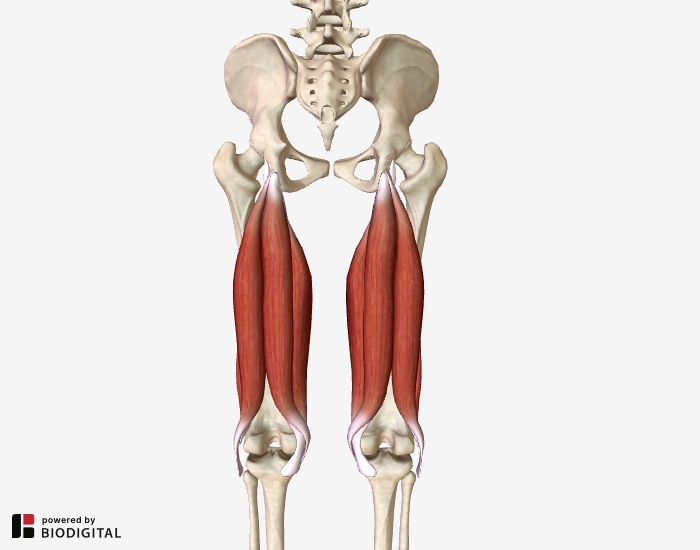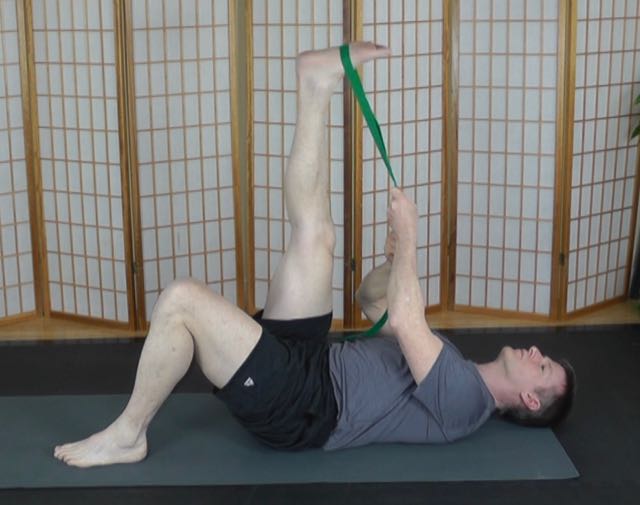Hamstring Stretches
to improve performance, prevent injury and relieve lower back pain
contents
 Posterior view of the left and right hamstring groups.
Posterior view of the left and right hamstring groups.Hamstring stretches are absolutely essential because the hamstring group -- the biceps femoris, the semitendinosus and the semimembranosus, pictured here -- are one of the most powerful and influential muscle groups in the body.
Left unattended, they will tighten and shorten over time which can lead, not only to discomfort in the hamstrings themselves, but also to more profound effects on posture, gait, and energy expenditure.
Every decade we age without addressing the hamstrings with regular stretching and also with complimentary toning for the quadriceps, the hamstrings antagonist, can leave us vulnerable to injury or chronic pain, especially lower back pain.
Hamstrings stretches and lower back pain
 Hamstring stretch using a looped yoga strap to assist.
Hamstring stretch using a looped yoga strap to assist.Hamstring stretches are among the most important of all stretches to relieve lower back pain.
The reason?
Tight hamstrings can "fix" the bottom of the pelvis from normal free movement. This "fixing," or lack of movement, can exert strain in the muscles of the lower back.
In addition, tight hamstrings can, in some cases, result in a twisted pelvis, also known as pelvic torsion.
Have you ever sensed that when standing up you were crooked?
This is caused by an imbalance in the muscles of the back, pelvis, and legs. The role that tight hamstrings can play in causing and/or maintaining pelvic torsion is considerable.
If one hamstring group is tighter and shorter than the other, the pelvic bone on that side can rotate into a posterior position relative to the other pelvic bone. This counter-rotation is what we mean by pelvic torsion.
Seated Hamstring Stretch
The Seated Hamstring Stretch is ideal for those who either cannot easily get up and down from the floor, or those who need a stretch that can easily been done at work.
- Scoot forward to the edge of your chair.
- Extend one leg at a time.
- Gently bend forward at the waist, just enough to feel the stretch in the hamstrings of the extended leg.
- Hold the stretch for 2 seconds only, then straighten up again.
- Repeat the forward bend at the waist and the 2-second stretch 5-7 reps.
- Each time, see if you can forward bend a little further.
- Repeat entire sequence on the other leg.
- If one leg is tighter, add an additional 3 reps on that side.
return to top
Hamstring Stretch Using Quadriceps Activation
This Hamstring Stretch Using Quadriceps Activation takes advantage of recriprocal inhibition: by contracting the antagonist muscle group of the hamstrings we signal them to relax and lengthen.
- Lying supine with the knees up and the foot on the floor, grab hold of the back of one thigh.
- Now begin to straighten that knee with the foot reaching for the ceiling, strongly contracting the quadriceps muscle, only extending as far as you can without forcing.
- Hold the stretch for only 2 seconds, then bend the knee again and return to neutral.
- Repeat straightening the leg and contracting the quadriceps 5-7 reps, each time seeing if you can extend a little further.
- Repeat entire sequence on the other leg.
- Add 3 reps for the tighter hamstrings group.
return to top
Beginner Hamstring Stretch With Yoga Strap
This Beginner Hamstring Stretch utilizes a looped yoga strap (any type of strap will work) to assist hamstring lengthening.
- Lying supine with the knees up and the foot on the floor, loop the strap around one foot.
- Now straighten the knee, guiding with the strap, with the foot pressing toward the ceiling until it reaches the end of its range of motion. It doesn't need to completely straighten.
- Now gently pull back with the strap to create a strong stretch for 2 seconds only then bend the knee and return to neutral.
- Repeat straightening the leg and guiding it with the strap into a deeper stretch for 5-7 reps, each time seeing if you can extend a little further.
- Repeat entire sequence on the other leg.
- Add 3 reps for the tighter hamstrings group.
return to top
intermediate Hamstring Stretches With Yoga Strap
The Intermediate Hamstring Stretch using a yoga strap will create a deeper stretch on the hamstring than the beginner version because it uses the momentum of the leg rising from the floor.
- Lying supine with one knee up and bent and the other leg straight on the floor with the strap looped around the foot.
- Now, actively lifting the straight leg toward the chest and guiding it with the strap, bring the leg up to its end range of motion and extend that range with a gently pull of the strap for a 2-second stretch.
- Return the leg all the way to the floor.
- Repeat this raising of the straight leg and guiding it with the strap for 5-7 reps, each time seeing if you can extend the stretch a little further.
- Repeat entire sequence on the other leg.
- Add 3 reps for the tighter hamstrings group.
return to top
Hamstring Stretch Using a Lunge
return to top
Standing Hamstring Stretch & Full-Body Mobilizer
return to top
Why do so many hamstring stretching techniques fail?
Hamstring stretches come in many shapes and sizes but they are not all created equal.
If you've ever tried in earnest to stretch your hamstrings but just couldn't make any progress, here's why…
You've probably been using static stretching.
We've all heard that the "gold standard" of stretching is to hold a stretch for 30 seconds or longer. This is how static stretching is done.
The problem with this approach, especially for muscles that are extremely short and tight, is that it often triggers what's called the protective stretch reflex.
If you've ever held an intense stretch (or tried to!) for 20 or 30 seconds and you've felt a shaking or quivering in the muscle, then you've experienced the protective stretch reflex.
The protective stretch reflex is a stress response in the muscle during which the muscle braces for action. Instead of lengthening the muscle fibers, static stretching can actually bind the muscle in an effort to protect it!
The Most Effective Stretching Method?
Active Isolated Stretching
Active Isolated Stretching (AIS) is the most effective stretching technique I've discovered, especially for very tight and short muscles that have resisted all other attempts to be lengthened.
AIS works for the following reasons:
1. The stretch is only held for 2 seconds which means it does provoke the protective stretch reflex.
2. The antagonist of the muscle being stretched is active engaged which results in reciprocal inhibition of the muscle being stretched.
3. The stretches are done without the muscle being stretched bearing weight. If a muscle is bearing weight while it is being stretched (such as is the case with certain standing hamstring stretches), the muscle is actually eccentrically contracted. This is not an optimal state to try to lengthen muscle fibers.
Why do I need to be careful about overstretching locked long hamstrings?
Have you ever tried to stretch the hamstrings of one leg because that side felt particularly, naggingly tight? But all attempts at stretching seemed to just aggravate the muscle?
If so then you may have experienced hamstrings that are "locked long."
When the pelvis becomes torqued so that one side is rotating in one direction and the other side is rotating in the other direction, the hamstrings will be locked short on one side and locked long on the other.
Picture a rubber band that's been pulled so taut that over time the rubber band begins to fail. This is a pretty good approximation of what's happening when your hamstrings are locked long.
The strategy, then, is to concentrate on lengthening the shorter of the two hamstrings.
Anatomy Images Courtesy of BIODIGITAL

|
CURRENT COURSES POSTURAL BLUEPRINT FOR CORRECTING PELVIC TORSION: The Complete Guide To Restoring Pelvic Balance (2022) STRETCHING BLUEPRINT FOR PAIN RELIEF & BETTER FLEXIBILITY: The Complete Guide to Pain-Free Muscles Using Active Isolated Stretching (2020) HEALING THE HIDDEN ROOT OF PAIN: Self-Treatment for Iliopsoas Syndrome (2013) FREE MINI COURSE: Introduction to Active Isolated Stretching |

